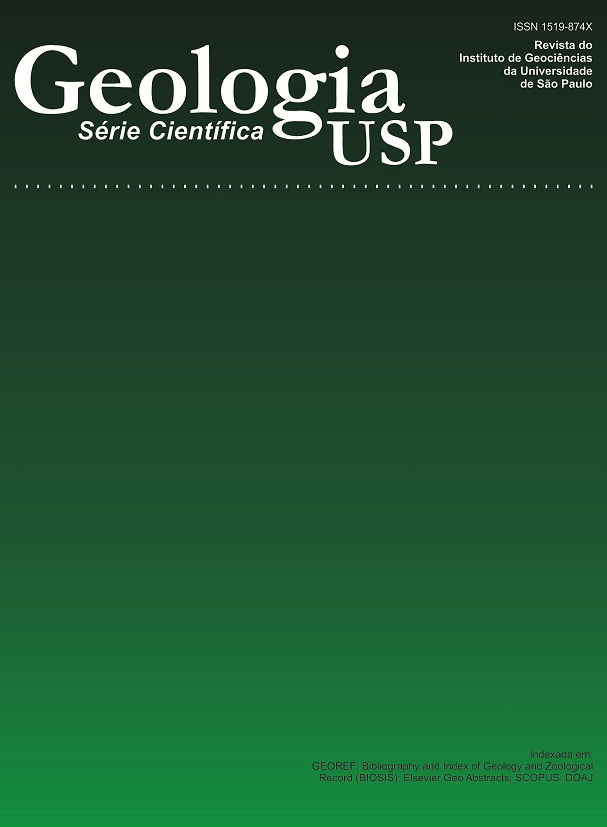Quartzo e zircão como marcadores da evolução magmático-hidrotermal do Granito Antônio Vicente, Suíte Intrusiva Velho Guilherme, Província Carajás
DOI:
https://doi.org/10.5327/Z1519-874X2013000200004Palavras-chave:
MEV-catodoluminescência, Quartzo, Zircão, GreisensResumo
Quatro tipos morfológico-texturais de quartzo, informalmente denominados Qz1, Qz2, Qz3 e Qz4, foram identificados nas diferentes fácies do Granito Antônio Vicente, Província Carajás, por meio de imagens de microscopia eletrônica de varredura-catodoluminescência (MEV-CL). Nas rochas menos evoluídas, contendo anfibólio e biotita, dominam cristais anédricos a subédricos bem desenvolvidos, luminescentes e intensamente fraturados (Qz1). Fluidos hidrotermais que percolaram o granito transformaram o quartzo magmático (Qz1) em Qz2 e Qz3 por meio de processos de alteração, dissolução e recristalização, sendo essas transformações muito mais evidentes nas rochas sienograníticas intensamente alteradas. O Qz4 forma cristais médios a grossos, geralmente luminescentes e comparativamente pouco fraturados. Sua ocorrência é restrita às rochas sienograníticas fortemente hidrotermalizadas e aos corpos de greisens, sugerindo o início do processo de greisenização. Nos greisens, dominam cristais de quartzo euédricos médios a grossos, zonados concentricamente e com feições típicas de origem hidrotermal (Qz5). Finos cristais de cassiterita zonada (≤ 100 µm) são comuns e preenchem cavidades nos tipos Qz4 e Qz5. Zircões dominantemente anédricos, corroídos, com os mais elevados conteúdos de Hf e as mais baixas razões Zr/Hf, pertencem às rochas mais evoluídas e alteradas hidrotermalmente e aos corpos de greisens associados, ambos portadores de mineralizações de Sn. Tal fato sugere que a assinatura geoquímica do zircão, em especial a razão Zr/Hf, pode ser utilizada na avaliação preliminar do potencial metalogenético de granitos estaníferos.Downloads
Os dados de download ainda não estão disponíveis.
Publicado
2013-06-01
Edição
Seção
Artigos
Licença
Autores que publicam nesta revista concordam com os seguintes termos:
- Autores mantém os direitos autorais e concedem à revista Geologia USP. Série Científica, o direito de primeira publicação, com o trabalho sob a licença Creative Commons BY-NC-SA (resumo da Licença: https://creativecommons.org/licenses/by-nc-sa/4.0 | texto completo da licença: https://creativecommons.org/licenses/by-nc-sa/4.0/legalcode) que permite o compartilhamento do trabalho de forma não comercial e conferindo os devidos créditos autorais da primeira publicação nesta revista.
- Autores têm autorização para assumir contratos adicionais separadamente, para distribuição não-exclusiva da versão do trabalho publicada nesta revista (publicar em repositório institucional ou como capítulo de livro), conferindo os devidos créditos autorais da primeira publicação nesta revista.
- Autores têm permissão e são estimulados a publicar e distribuir seu trabalho online (em repositórios institucionais ou na sua página pessoal) a qualquer ponto antes ou durante o processo editorial, uma vez que isso pode gerar alterações produtivas, bem como aumentar o impacto e a citação do trabalho publicado (Veja O efeito do Acesso Aberto e downloads no impacto das citações).
Como Citar
Lamarão, C. N., Rocha, K. K. N., Marques, G. T., & Borges, R. M. K. (2013). Quartzo e zircão como marcadores da evolução magmático-hidrotermal do Granito Antônio Vicente, Suíte Intrusiva Velho Guilherme, Província Carajás . Geologia USP. Série Científica, 13(2), 49-68. https://doi.org/10.5327/Z1519-874X2013000200004















